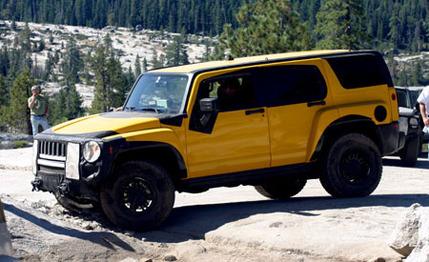
 First Drive Review
First Drive Review
Hummer is still a novelty brand. The mammoth H2 is the vehicle to buy if your neighbor heads up the local Sierra Club chapter and you don't like him at all. It sells more on its affectations than its abilities, but with sales drooping, the novelty of those affectations is fading. The challenge for GM is for Hummer to earn some street cred for genuine ability before launching the next, smaller SUV-and it's expected to be the line's bestseller-so it can confront Jeep head on. And the way to do that is to get as far away from the street as possible.
So they brought five prototypes of the 2006 Hummer H3 to northeast California's spectacularly beautiful Rubicon Trail-Jeep's semiofficial proving ground, namesake of the Wrangler Rubicon-and invited four automotive writers along on a two-day development trek up the legendary granite-and-dust nonroad. Both camping and seeing GM engineers without their shirts on were among the program's unique features.
The five H3s were culled from a group of 78 "integration vehicles" built with "production intent" parts and used for final tuning and safety testing (half of the 78 were destroyed in barrier crashes). They're dang close to the production H3s that will be in Hummer dealers' Quonset huts next summer wearing a base price of about $30,000, even though the interiors lacked some trim and graining on the plastic and the exteriors wore dorky camouflage. The four gray H3s varied slightly in gearing and equipment, but all ran GM's 4L60-E four-speed automatic transmission. The sole yellow H3 had a five-speed manual transmission.
Derived from the Chevrolet Colorado and GMC Canyon pickups, the H3 shares those trucks' body-on-frame construction; double-A-arm and torsion-bar front and leaf-spring rear suspension systems; and 220-hp, 3.5-liter DOHC 20-valve all-aluminum inline five-cylinder Vortec engine (the only engine offered).
At 186.7 inches long, the H3 is 4.9 inches shorter than a GMC Envoy; its 111.9-inch wheelbase is only 1.1 inches shorter than that mid-size SUV's. Compared with the H2, the H3 is 16.8 inches less lengthy overall and rides on a wheelbase that is 10.9 inches shorter. The slab-sided H3 may superficially resemble the old slab-sided 1984-to-2001 Jeep Cherokee, but it's 19.2 inches longer. And although GM is still paring down the H3's heft, it weighs well over two tons. This is a smaller Hummer, but it's not small.
The H3's most important components on the Rubicon were 33-inch-tall LT285/75R-16 Bridgestone Dueler A/T tires, part of the ZM6 Off-Road Adventure package carried by all five vehicles (base H3s will get 31-inch-tall P265/75R-16 Goodyears); the electronically controlled dual-range transfer case; and the electronically engaged locking rear differential. As was incessantly made clear to the engineers on hand, a locking front diff would also be a boon for rock crawlers, but they'll have to learn to work with the traction-control system instead.
The Rubicon Trail is only about 11 or 12 miles long (depending on who's measuring and route variations), starting in the western Sierra Nevada Mountains and running to the western shore of Lake Tahoe. It's thoroughly rugged, and the parts of it that don't require crawling over granite boulders usually include crossing granite outcroppings. It's literally the standard against which other off-road routes are measured.
Starting at Wentworth Springs with tires running 20 pounds of inflation, we immediately put the H3s in low range to begin the two-day crawl and stayed there throughout the trip. With speeds rarely exceeding 5 mph, the H3s truly are adept and nimble climbers. There's a lot of travel in the suspension, the approach angles are generous, the steering is precise but doesn't buck much when pounding into rocks, the five-cylinder engine's throttle is progressive just off idle, and the four-wheel-drive and traction-control systems work seamlessly together under most conditions. The structure of the H3 is impressively stiff, which is particularly evident as the truck slides off rocks to slam down hard on the skid plates with solid thunks and few shudders.
Even in its incomplete and unfinished state, the H3's five-passenger interior is a big step forward from that of the H2 in that it's cleanly styled, with straightforward controls, and lacks the H2's frippery and overwhelming self-consciousness. The squat window line and long hood limit visibility a bit, but on the Rubicon all that really matters is that you can see your spotter's hands.
For most Hummer buyers, off-road ability means something like easily trudging out of the muddy parking lot at a horse show; that the H3 can conquer the Rubicon is impressive, reassuring, and ego swelling but ultimately academic. There's nothing on the Rubicon that simulates parallel parking, commuting along I-5, or climbing the speed bumps at Target. In fact, the trail doesn't even offer a chance to rev the H3's engine much beyond its torque peak of 225 pound-feet at 2800 rpm or get the transmission out of first gear. Nor can we tell you how the truck rides on fully inflated tires.
So the big test for the Hummer H3 still lies ahead when it confronts the everyday world of its potential buyers, a world in which the appeal of overall competence never fades.